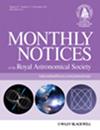Simulating stellar coronal rain and slingshot prominences
IF 4.8
3区 物理与天体物理
Q1 ASTRONOMY & ASTROPHYSICS
引用次数: 0
Abstract
We have numerically demonstrated that simulated cool star coronae naturally form condensations. If the star rotates slowly, with a co-rotation radius greater than the Alfvén radius (i.e. RK > RA), these condensations will form below the co-rotation radius RK and simply fall back to the stellar surface as coronal rain. If, however, the star is more rapidly rotating, (RK < RA), not only rain will form but also “slingshot prominences”. In this case, condensations collect into a large mass reservoir around the co-rotation radius, from which periodic centrifugal ejections occur. In this case, some 51% of the coronal mass is cold gas, either in rain or prominences. We find that 21% of the mass lost by our simulated fast rotating star is cold gas. Studies of stellar mass-loss from the hot wind do not consider this component of the wind and therefore systematically underestimate mass-loss rates of these stars. Centrifugal ejections happen periodically, between every 7.5 - 17.5 hours with masses clustering around 1016 g, These results agree well with observational statistics. Contrasting the fast and slow rotating magnetospheres, we find that there are two distinct types of solutions, high lying and low lying loops. Low lying loops only produce coronal rain whereas high lying loops produce both rain and slingshots.模拟恒星日冕雨和弹弓状突出物
我们已经用数值证明,模拟的冷恒星日冕会自然形成凝聚。如果恒星旋转缓慢,同转半径大于阿尔弗文半径(即 RK > RA),这些凝聚体将在同转半径 RK 以下形成,并以日冕雨的形式简单地落回恒星表面。然而,如果恒星的自转速度更快(RK < RA),则不仅会形成日冕雨,还会形成 "弹弓状突出"。在这种情况下,冷凝物会在同向旋转半径周围聚集成一个巨大的质量库,并从中发生周期性的离心喷射。在这种情况下,大约 51% 的日冕质量是冷气体,要么是雨状质量,要么是突出质量。我们发现,我们模拟的快速旋转恒星所损失的质量中有 21% 是冷气体。对热风造成的恒星质量损失的研究没有考虑热风的这一部分,因此系统性地低估了这些恒星的质量损失率。离心喷射周期性地发生,每 7.5 - 17.5 小时一次,质量集中在 1016 g 左右,这些结果与观测统计数据非常吻合。对比快速和慢速旋转的磁层,我们发现有两种不同类型的解决方案:高位环和低位环。低平环只产生日冕雨,而高平环同时产生日冕雨和弹弓。
本文章由计算机程序翻译,如有差异,请以英文原文为准。
求助全文
约1分钟内获得全文
求助全文
来源期刊

Monthly Notices of the Royal Astronomical Society
ASTRONOMY & ASTROPHYSICS-
CiteScore
9.10
自引率
37.50%
发文量
3198
审稿时长
3 months
期刊介绍:
Monthly Notices of the Royal Astronomical Society is one of the world''s leading primary research journals in astronomy and astrophysics, as well as one of the longest established. It publishes the results of original research in positional and dynamical astronomy, astrophysics, radio astronomy, cosmology, space research and the design of astronomical instruments.
 求助内容:
求助内容: 应助结果提醒方式:
应助结果提醒方式:


